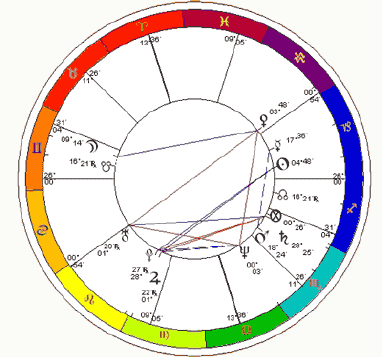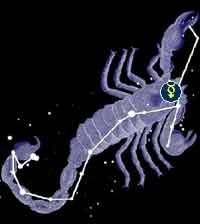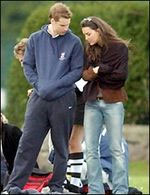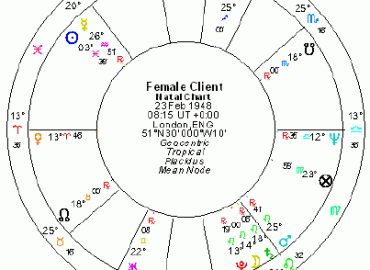Darrelyn Gunzburg
August 2005
Much of my case load as a consulting astrologer concerns working with people in grief. A person in grief expresses both a uniqueness fit to their distinctive situation of loss and, at the same time, a shared experience of bodily and emotional pain. I thought it might be interesting to consider how the heliacal rising star offers us an understanding of the unique part of a person’s journey through that sacred space of suffering.
Perhaps the easiest way to see this is to take the case study of Hannah, written up in my book Life After Grief: An Astrological Guide to Dealing with Loss (The Wessex Astrologer, 2004).
Hannah’s heliacal rising star, the soil into which Hannah’s chart is seeded, is Alphecca. Starlight says of this star, in this position:
HELIACAL RISING STAR
Alphecca – Being guided by a strong belief in your own abilities or ideas
Emerging from the Underworld into the light of day, Alphecca gives Hannah a belief in her own ideas and her own abilities. In its mythology Alphecca is a woman’s crown, a garland of flowers, not the crown offered to the challenge-orientated solar hero but one of receptivity and empathy, the yin experience. Such a crown contains hidden thorns, yet standing in the position of the helical rising star, these “thorns”, her family’s deep-seated ancestral pattern and the expectations of her peers and family, can act as a fount from which she can draw in order for her to understand her personal life mission and her personal abilities and thus to realize her dreams.

Hannah – 27 Dec, 1955. 6.25 pm Sydney, Australia.
Some of you may have read Hannah’s story. If not, here it is in brief:
Hannah’s marriage in youth had lasted only seven years, resulting in a pre-Saturn return divorce. On the rebound from a subsequent affair, Hannah fell pregnant. Full of shame, she made the decision to have a termination. Some weeks later, feeling as if she was still pregnant, she returned to her doctor. The doctor performing the abortion had not accounted for a second embryo, a twin pregnancy. Hannah’s decision to go ahead and have this second baby, however, was thwarted when the baby died in utero at just under eight months pregnant. Full of guilt and remorse, believing she had wished this baby dead, Hannah retreated to country teaching and what she envisaged as a new life of anonymity.
Fourteen years later Hannah returned to live in the city – and the scenario repeated itself: Hannah fell pregnant and made the decision to abort. However, once again the doctor performing the operation failed to pick up the second embryo. When Hannah visited her mother not long after this event, of her own volition and knowing nothing of Hannah’s two twin pregnancies, her mother told her a story form her past. When her mother was first married she had fallen pregnant and the baby had died in the womb. Some months’ later, feeling most unwell, her mother had gone to see the doctor. The doctors were of the opinion that Hannah’s mother could not possibly still be pregnant but she was – with Hannah. Hannah was one of a twin. The other twin had died in the womb. Not only that but her grandmother and her great-grandmother had also lost babies. Four generations of women had a repeating pattern of infant loss.
Of course we can look at Hannah’s natal chart and understand this story through Hannah’s Moon – in Gemini in the 12thhouse conjunct the South Node. In Hannah’s chart her emotional wellbeing was intimately tied up with this inherited family pattern of the lost twin. We can also look at this from the perspective of Alphecca, for the heliacal rising star in a chart bears gifts from the land of one’s past, one’s family and one’s genetics. It is a jewel, a treasure handed to one from one’s ancestors. In Hannah’s case it is more obvious due to the pattern that threaded itself through the women in her family – yet when she believed it was her sole journey, it was something of which she was initially ashamed.
The thorns on the crown of Alphecca, the long years of feeling humiliated and mortified at her unwanted pregnancy and the subsequent guilt of loss and grief, cut her in the extreme, even as her family’s deep-seated ancestral pattern of which no-one spoke continued to tap out its beat. Yet it is this that has turned out to be the crown offered to Hannah, ready for her to extract its myths in order for her to understand her personal life mission and her personal abilities so that she can help others as a gifted musician, teacher and writer.




